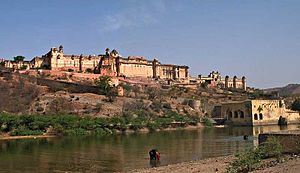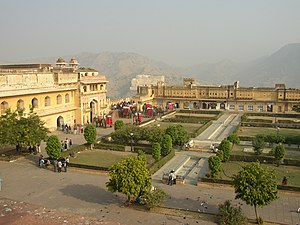Amber, India
From Wikipedia, the free encyclopedia
Jump to: navigation, search
Amber, India
Coordinates: (find coordinates)
Country ![]() India
India
Interior of one of the palaces in Amber Fort
The fort in 1985
Amber was a city of Rajasthan state, India, it is now part of the Jaipur Municipal Corporation. Founded by the Meena Raja Alan singh (He was from Chanda clan of Meenas), Amber was a flourishing settlement as far back as 967 AD. Around 1037 AD, it was conquered by the Kachwaha clan of Rajputs. Much of the present structure known as Amber fort is actually the palace built by the great conqueror Raja Man Singh I who ruled from 1590 - 1614 AD. The palace contains several spectacular buildings such as the Diwan-i-Khas and the elaborately painted Ganesh Poll built by the renowned warlord Mirza Raja Jai Singh I (Man Singh I's grandson). The old and original fort of Amber dating from earlier Rajas or the Meena period is what is known in the present day as Jaigarh fort, which is actually the main defensive structure, rather than the palace itself, although the two structures are interconnected by series of encompassing fortification.
Amber was capital of the Kachwahas until 1727 when the ruler of Amber Sawai Jai Singh II founded a capital about nine kilometers south of Amber, this new city which was named after him as Jainagara (Jaipur). After the founding of the new town, the royal palace and houses of prominent persons were shifted to Jaipur, but the priests of Shila Devi temple who were Bengali Brahmins continued to live in the fort(to this date), while the Jaigarh fort above the palace also remained heavily garrisoned. The capital of Kachwahas was supplanted by the modern city of Jaipur, which is the capital of Rajasthan state in India.
The picturesque situation of Amber at the mouth of a rocky mountain gorge, in which nestles a lovely lake, has attracted the admiration of all travelers, including Victor Jacquemont and Reginald Heber. It is seen to be a remarkable example for its combined Rajput-Mughal architecture. The first Rajput structure was started by Raja Kakil Dev when Amber became his capital in 1036 on the site of present day Jaigarh Fort.
"No sooner had Mirza completed the Diwan-i-Khas" it is related [citation needed] "than it came to the ears of the emperor Jahangir that his vassal had surpassed him in magnificence, and that this last great work quite eclipsed all the marvels of the imperial city; the columns of red sandstone having been particularly noticed as sculptured with exquisite taste and elaborate detail. In a fit of jealousy the emperor commanded that this masterpiece should be thrown down, and sent commissioners to Amber charged with the execution of this order; whereupon Mirza, in order to save the structure, had the columns plastered over with stucco, so that the messengers from Agra should have to acknowledge to the emperor that the magnificence, which had been so much talked of, was after all pure invention. Since then his apathetic successors have neglected to bring to light this splendid work; and it is only by knocking off some of the plaster that one can get a glimpse of the sculptures, which are perfect as on the day they were carved."
According to some local tradition, the story of the conquest of Amber from the Meenas, is that the Meena Raja Ralun singh also known as Alan Singh Chanda [1] of Khogong kind-heartedly adopted a stranded Rajput mother and her child who sought refuge in his realm. Later, the Meena king sent the child, Dhola Rae, to Delhi to represent the Meena kingdom. The Rajput, in gratitude for these favours, returned with Rajput conspirers and massacred the weaponless Meenas on Diwali while performings rituals i.e PitraTrapan, it is customary in Meenas to be weaponless at the time of PitraTrapan , "filling the reservoirs in which the Meenas bathed with their dead bodies" [Tod.II.281] and thus conquered Khogong. He then subjugated the Sihra Gotra of Meenas at much later on known as Jamwa Ramgarh near Jaipur, and transferred his capital thence. Becoming the son-in-law of the prince of Ajmer, he died when battling 11,000 Meenas, most of whom he slew [Tod.II.282]. His son Maida Sihra l Rao "made a conquest of Amber from the Soosawut Meenas" whose chief was the head of the Meena confederation. He subdued the Nandla Meenas, annexing the Gatoor-Gatti district [Tod.II.282]. Hoondeo succeeded to the throne and "continued the warfare against the Meenas" [Tod.II.282]. Koontal, his successor, fought the Meenas "in which the Meenas were defeated, with great slaughter, which secured his rule throughout Dhoondar" [Tod.II.282]. The Meenas were the original builders of Amber, which town they consecrated to Amba, the Mother Goddess, whom they knew as "Gatta Rani" or "Queen of the Pass" [Tod.II.282]. The Meenas being fierce and renowned warriors, nonetheless became a great allies of the Rajputs.





No comments:
Post a Comment